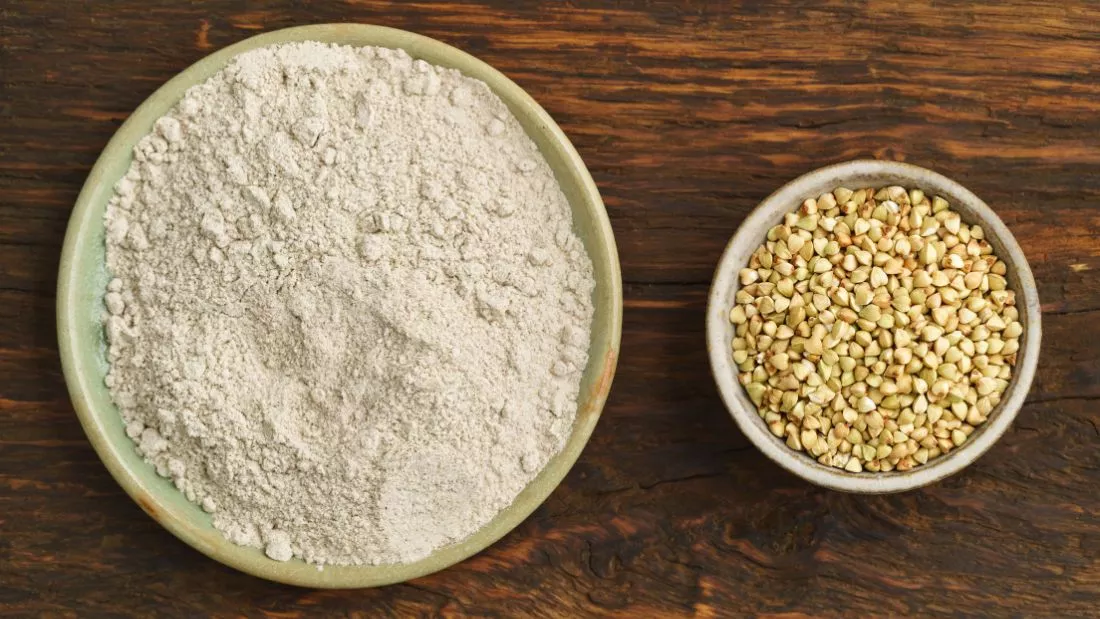Buckwheat

Discover this super-versatile, nutritious seed
What is buckwheat?
Despite its name, buckwheat is not even remotely related to wheat. In fact, it’s not a cereal at all but because its seeds have a high starch content and you can use it in the same way as other cereals, it is known as a pseudocereal. Surprisingly, the closest buckwheat relatives are sorrel, knotweed and rhubarb.
Historical records show that buckwheat has been grown for at least 6,000 years in China and has been cultivated for thousands of years in other Asian countries and across the Tibetan Plateau.
Buckwheat nutrition
Buckwheat is incredibly nutritious – see the overview table. The protein in buckwheat is high quality because it contains all essential amino acids in the right proportions, making buckwheat a protein champ!
However, the main nutrient in buckwheat is starch – a healthy, complex carbohydrate that slowly releases its energy and is therefore good for you! On top of that, buckwheat provides resistant starch which helps to make you feel fuller after a meal and prevents blood sugar spikes.
Buckwheat is a great source of several essential nutrients as illustrated by the table and it also supplies a range of B vitamins but only in relatively small amounts.
| Nutrient | One cup of cooked groats (168 g) | One cup of buckwheat flour (120 g) | Recommended daily intake |
| Protein | 6 g | 15 g | 45-56 g |
| Carbohydrates + fibre | 31 + 5 g | 73 + 12 g | No specific recommendation + 30 g |
| Fat | 1 g | 4 g | No specific recommendation |
| Vitamin K | 3 µg | 8 µg | 70 µg |
| Calcium | 12 mg | 50 mg | 700 mg |
| Iron | 1 mg | 5 mg | 8.7 mg (all men and women over 50; 14.8 mg women under 50) |
| Magnesium | 86 mg | 301 mg | 300 mg |
| Zinc | 1 mg | 4 mg | 7 mg (women) and 9.5 mg (men) |
Phytochemicals
Buckwheat contains a whole range of powerful phytochemicals – natural plant compounds with positive health effects.
One of the best-known is the flavonoid rutin, which can improve your blood vessel strength and flexibility and so help to prevent, or treat, conditions such as spider veins and varicose veins – and some studies show that it can aid in treating haemorrhoids, too. It also helps your body produce collagen and use vitamin C, may reduce cholesterol levels and cancer risk and it may offer some pain relief to arthritis sufferers.
Another buckwheat phytochemical is quercetin – an antioxidant that reduces inflammation, cancer risk and the risk of heart disease.
The same phytochemicals that make green tea so good for you – catechins – are also found in buckwheat. They are antioxidants that not only protect our cells and tissues from everyday damage but are also anti-inflammatory, help support the immune system and promote beneficial gut bacteria.
Buckwheat health benefits
Buckwheat consumption has a number of health benefits that are linked to its antioxidants, fibre, starchy carbohydrates, micronutrients and its low fat content. Research shows it may help to prevent heart disease, lower cholesterol levels, reduce your risk of developing cancer, protect your brain from ageing prematurely, fight inflammation and support your immune system.
All the fibre, starch and antioxidants in buckwheat promote good gut bacteria, which help to keep your gut wall strong and that, in turn, helps to protect your overall health. Of course, it also means buckwheat is excellent for your digestive system, keeping you regular and preventing inflammatory conditions that may affect the intestines.
Buckwheat carbohydrates provide slow energy release and don’t cause your blood sugar to rise rapidly – that’s why it’s not just a healthy food but also a perfect staple for people at risk or with diabetes. Studies revealed that buckwheat may also help to improve blood sugar regulation in diabetics.
Gluten-free hero
Buckwheat is naturally gluten-free and makes an excellent alternative to wheat for gluten intolerant people. However, buckwheat flour can be contaminated with gluten so if you want to be sure, choose a product that carries “gluten-free” label.
How to use buckwheat?
If you buy a bag of buckwheat groats, which are hulled buckwheat seeds, you can use them in place of rice, oats or quinoa in both sweet and savoury dishes. When cooked, the hard, crunchy seeds soften but when you roast them, they remain slightly crunchy and can add great texture to your dishes.
Another popular buckwheat food is soba noodles – traditionally, this Japanese classic is made only from buckwheat but in the UK, it is usually made from a mixture of wheat and buckwheat flour. If you’d like to try the traditional Japanese soba noodles, prepare to spend a little more money.
Buckwheat flour is great for pancakes, waffles, banana bread, biscuits, cakes and flatbreads – and it makes them extra nutritious.
Find buckwheat recipes at our Vegan Recipe Club!
A crop for the future
Buckwheat is one of the most sustainable crops as it can be cultivated in a number of climates and thrives even in high altitude regions with low rainfall and low temperatures. Its cultivation doesn’t demand much in the way of resources and so is usually a very affordable food. Thanks to its rich nutrient profile, it may be just the food that we’ll rely more and more on in the future.




